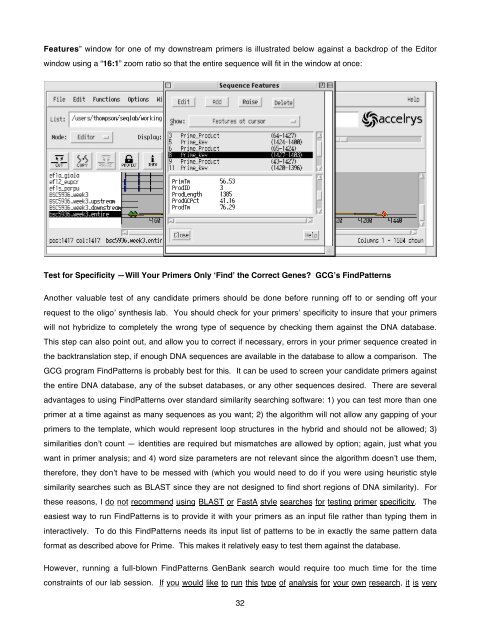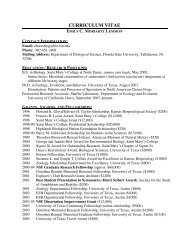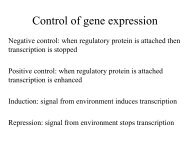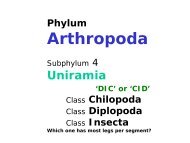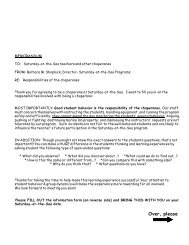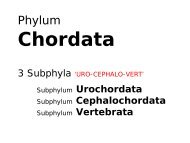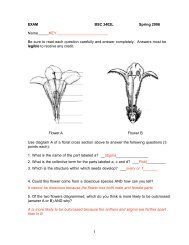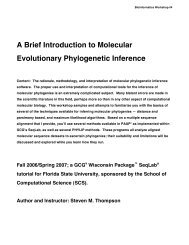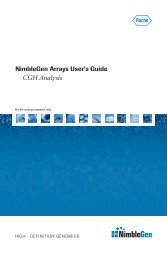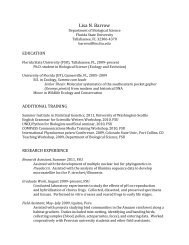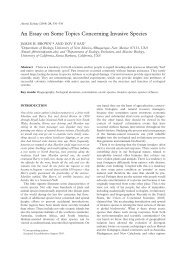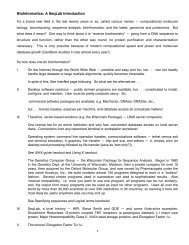Unknown DNA â Rational Primer Design and Analysis â the ...
Unknown DNA â Rational Primer Design and Analysis â the ...
Unknown DNA â Rational Primer Design and Analysis â the ...
You also want an ePaper? Increase the reach of your titles
YUMPU automatically turns print PDFs into web optimized ePapers that Google loves.
Features” window for one of my downstream primers is illustrated below against a backdrop of <strong>the</strong> Editor<br />
window using a “16:1” zoom ratio so that <strong>the</strong> entire sequence will fit in <strong>the</strong> window at once:<br />
Test for Specificity —Will Your <strong>Primer</strong>s Only ‘Find’ <strong>the</strong> Correct Genes? GCG’s FindPatterns<br />
Ano<strong>the</strong>r valuable test of any c<strong>and</strong>idate primers should be done before running off to or sending off your<br />
request to <strong>the</strong> oligo’ syn<strong>the</strong>sis lab. You should check for your primers’ specificity to insure that your primers<br />
will not hybridize to completely <strong>the</strong> wrong type of sequence by checking <strong>the</strong>m against <strong>the</strong> <strong>DNA</strong> database.<br />
This step can also point out, <strong>and</strong> allow you to correct if necessary, errors in your primer sequence created in<br />
<strong>the</strong> backtranslation step, if enough <strong>DNA</strong> sequences are available in <strong>the</strong> database to allow a comparison. The<br />
GCG program FindPatterns is probably best for this. It can be used to screen your c<strong>and</strong>idate primers against<br />
<strong>the</strong> entire <strong>DNA</strong> database, any of <strong>the</strong> subset databases, or any o<strong>the</strong>r sequences desired. There are several<br />
advantages to using FindPatterns over st<strong>and</strong>ard similarity searching software: 1) you can test more than one<br />
primer at a time against as many sequences as you want; 2) <strong>the</strong> algorithm will not allow any gapping of your<br />
primers to <strong>the</strong> template, which would represent loop structures in <strong>the</strong> hybrid <strong>and</strong> should not be allowed; 3)<br />
similarities don’t count — identities are required but mismatches are allowed by option; again, just what you<br />
want in primer analysis; <strong>and</strong> 4) word size parameters are not relevant since <strong>the</strong> algorithm doesn’t use <strong>the</strong>m,<br />
<strong>the</strong>refore, <strong>the</strong>y don’t have to be messed with (which you would need to do if you were using heuristic style<br />
similarity searches such as BLAST since <strong>the</strong>y are not designed to find short regions of <strong>DNA</strong> similarity). For<br />
<strong>the</strong>se reasons, I do not recommend using BLAST or FastA style searches for testing primer specificity. The<br />
easiest way to run FindPatterns is to provide it with your primers as an input file ra<strong>the</strong>r than typing <strong>the</strong>m in<br />
interactively. To do this FindPatterns needs its input list of patterns to be in exactly <strong>the</strong> same pattern data<br />
format as described above for Prime. This makes it relatively easy to test <strong>the</strong>m against <strong>the</strong> database.<br />
However, running a full-blown FindPatterns GenBank search would require too much time for <strong>the</strong> time<br />
constraints of our lab session. If you would like to run this type of analysis for your own research, it is very<br />
32


